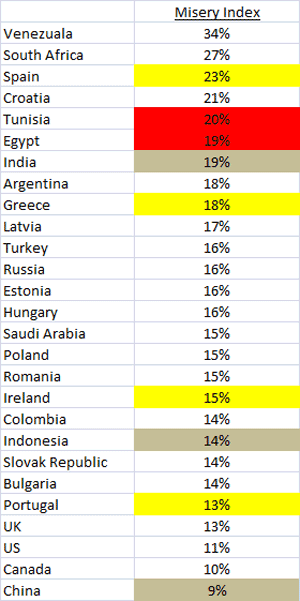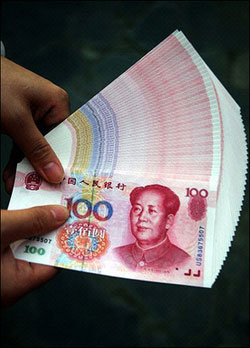Egypt’s Civil Unrest Could Spread to Asia, What It Means for Your Investments!
Stock-Markets / Emerging Markets Feb 05, 2011 - 12:25 PM GMTBy: Bryan_Rich
 In recent weeks we’ve seen riots in Algeria, a coup in Tunisia and a massive public uprising in Egypt. The catalyst: The combination of skyrocketing food prices and high, persistent unemployment.
In recent weeks we’ve seen riots in Algeria, a coup in Tunisia and a massive public uprising in Egypt. The catalyst: The combination of skyrocketing food prices and high, persistent unemployment.
But while most are focusing on the specific political shortcomings within the countries and dismissing the events as isolated and contained, the lessons learned from this global economic crisis give every reason to expect contagion …
- The subprime crisis was said to be contained. But it wasn’t.
- The failing of major U.S. financial institutions was said to be contained. But it wasn’t.
- The sovereign debt crisis in Greece was said to be contained. But it wasn’t.
Now, global politicians and financial market experts are hoping the latest events will be isolated and contained. But, they likely won’t.
Here’s why …
Spreading Discontent
This dangerous combination of persistent unemployment and rapidly rising food inflation isn’t just specific to North Africa and the Middle East. Global unemployment remains at record levels. And world food prices rose to a record in January.
The expanding unrest is most vulnerable in those countries with low per capita income, where people may spend as much as 70 percent of their income on food. Moreover, the threat of civil disorder rises when those countries have significant income inequality and/or have gone through major economic stress where the outlook for a return to normalcy looks bleak.
In this environment, there are many countries that fit the bill. Take a look at how risks in other parts of the world stack up against Egypt and Tunisia.
The table below is a gauge of economic misery across the biggest countries in the world. This index was created by a former economic advisor to President Lyndon Johnson, Arthur Okun. It simply takes the sum of inflation and unemployment rates. According to his index, the higher the index value the more miserable life is in these countries.

You can see that Tunisia and Egypt, two countries that have already erupted in crisis, are among the most miserable.
Also note the position of the weakest euro-zone countries — Portugal, Ireland, Greece and Spain — all of which have been forced into stifling austerity plans by the IMF and their European neighbors.
We’ve already seen massive protests in recent months, both from those countries taking money … and from those giving money. And growing inter-European political fractures and languishing economic activity promise more social volatility ahead.
Asia at Even Greater Risk!
Perhaps the biggest potential threat within this table is a spread of public uprising to the three Asian countries that have been important drivers of global economic recovery: Indonesia, India and China.
|
Food prices in Indonesia and India have risen 16 percent and 17 percent, respectively, over the past year. And while China’s misery index is on the bottom of this list, it’s risen 40 percent in the past year.
Remember, China still has the world’s second largest poor population, with 135 million people living on less than one U.S. dollar a day. The largest poor population: India.
So a backlash in China or India could stop the global economic recovery dead in its tracks!
That’s why, despite all of the global pressure on China to stop manipulating global trade through its weak currency advantage, it is unwilling to make meaningful concessions. The risk of losing exports, and therefore losing jobs, is a recipe for violent protests and too big of a risk for China’s ruling Communist Party to take.
To be sure, major problems in China are major problems for the rest of the world. Yet, the pressures on China to strengthen the yuan will continue to grow, because its currency policy promises to keep the global economy imbalanced, and stuck in the current cycle of booms and busts.
If the China problem sounds like a conundrum, you’re right, it is.
Still, recent meetings of world economic and financial leaders in Davos, Switzerland were filled with optimism about the global recovery.
But for all of the reasons I’ve touched on here, IMF chief Dominique Strauss-Kahn followed those meetings with warnings this week that the growing divisions between countries and within countries pose the risks of global protectionism and war.
If in fact, we see a spread of public backlash across the world, it’s fair to expect global investors will, again, pull in their horns. And we’ll likely see the risk aversion dynamic return to global markets in a hurry.
That means weaker global stock markets, falling commodities, a flight from emerging market currencies and a rise in the dollar.
Regards,
Bryan
This investment news is brought to you by Money and Markets. Money and Markets is a free daily investment newsletter from Martin D. Weiss and Weiss Research analysts offering the latest investing news and financial insights for the stock market, including tips and advice on investing in gold, energy and oil. Dr. Weiss is a leader in the fields of investing, interest rates, financial safety and economic forecasting. To view archives or subscribe, visit http://www.moneyandmarkets.com.
© 2005-2022 http://www.MarketOracle.co.uk - The Market Oracle is a FREE Daily Financial Markets Analysis & Forecasting online publication.




